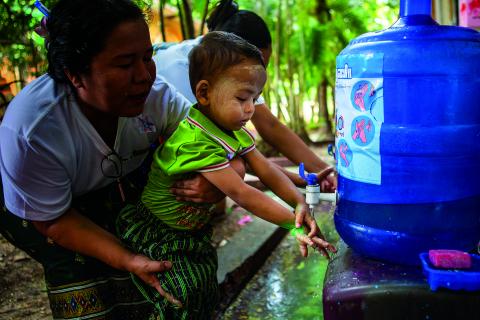Can WASH factors and interventions prevent severe wasting relapse? A systematic review
This is a summary of the following paper: MacLeod C, Ngabirano L, N'Diaye DS, Braun L, & Cumming O (2024). Household-level water, sanitation and hygiene factors and interventions and the prevention of relapse after severe acute malnutrition recovery: A systematic review. Maternal & Child Nutrition, 20, e13634. https://doi.org/10.1111/mcn.13634
Community-based Management of Acute Malnutrition (CMAM) has proven effective in treating severe wasting. However, many children relapse after discharge, often within the first three months. Severe wasting relapse occurs when a child who has recovered from an outpatient therapeutic programme (OTP) becomes severely wasted again. Reported relapse rates vary significantly, ranging from 0% to 37%, highlighting a major gap in sustaining long-term recovery. Poor water, sanitation, and hygiene (WASH) conditions are known risk factors for undernutrition, contributing to about 16% of the global burden in children under five. However, there is limited evidence on whether improving household WASH conditions can prevent severe wasting relapse. Repeated diarrhoeal infections, intestinal parasites, and environmental enteric dysfunction caused by poor WASH increase a child’s vulnerability, making them more likely to relapse after treatment.
This systematic review assessed whether household-level WASH interventions can help prevent severe wasting relapse and aimed to identify key WASH-related risk factors for relapse. The review analysed studies published after 2000, focusing on children aged 6-59 months post-OTP discharge. Despite a comprehensive search, only three studies met the inclusion criteria, revealing a significant gap in research on this issue. Findings were inconsistent due to small sample sizes, differing definitions of relapse, and variations in follow-up duration. One intervention study evaluated the impact of providing household WASH kits during OTP treatment and post-discharge. It found no significant reduction in relapse rates at two- and six-month follow-ups, possibly because the supplies were only provided for one month post-discharge. Two observational studies examined links between WASH conditions, such as unsafe drinking water and poor sanitation and severe wasting relapse, but the results were inconsistent. Variability in relapse rates between studies may be explained by differences in OTP admission and discharge criteria, tracking methods, and follow-up duration.
The available evidence, though limited, suggests that children recovering from severe wasting remain highly vulnerable and that CMAM services alone may not be enough to sustain recovery. Addressing relapse risk requires a better understanding of which WASH interventions are most effective, particularly in the critical first three months after discharge when children are at the highest risk of becoming severely wasted again.
Some limitations of this study were noted. The study could have had a broader inclusion criterion, since the small number of eligible studies and the varied study designs made it challenging to identify clear trends. The definition of relapse used could have focused on studies that looked at including relapse to moderate wasting as well. While the review focused on household-level interventions, exploring the potential impact of community-level interventions could provide valuable insights into reducing relapse rates. Discussion of the findings on the evidence of WASH interventions and the prevention of undernutrition could have been expanded upon. Future studies should explore locally adapted approaches that reduce environmental contamination, improve household hygiene, and ensure that recovered children stay healthy, thus reducing the burden of malnutrition in vulnerable communities.


